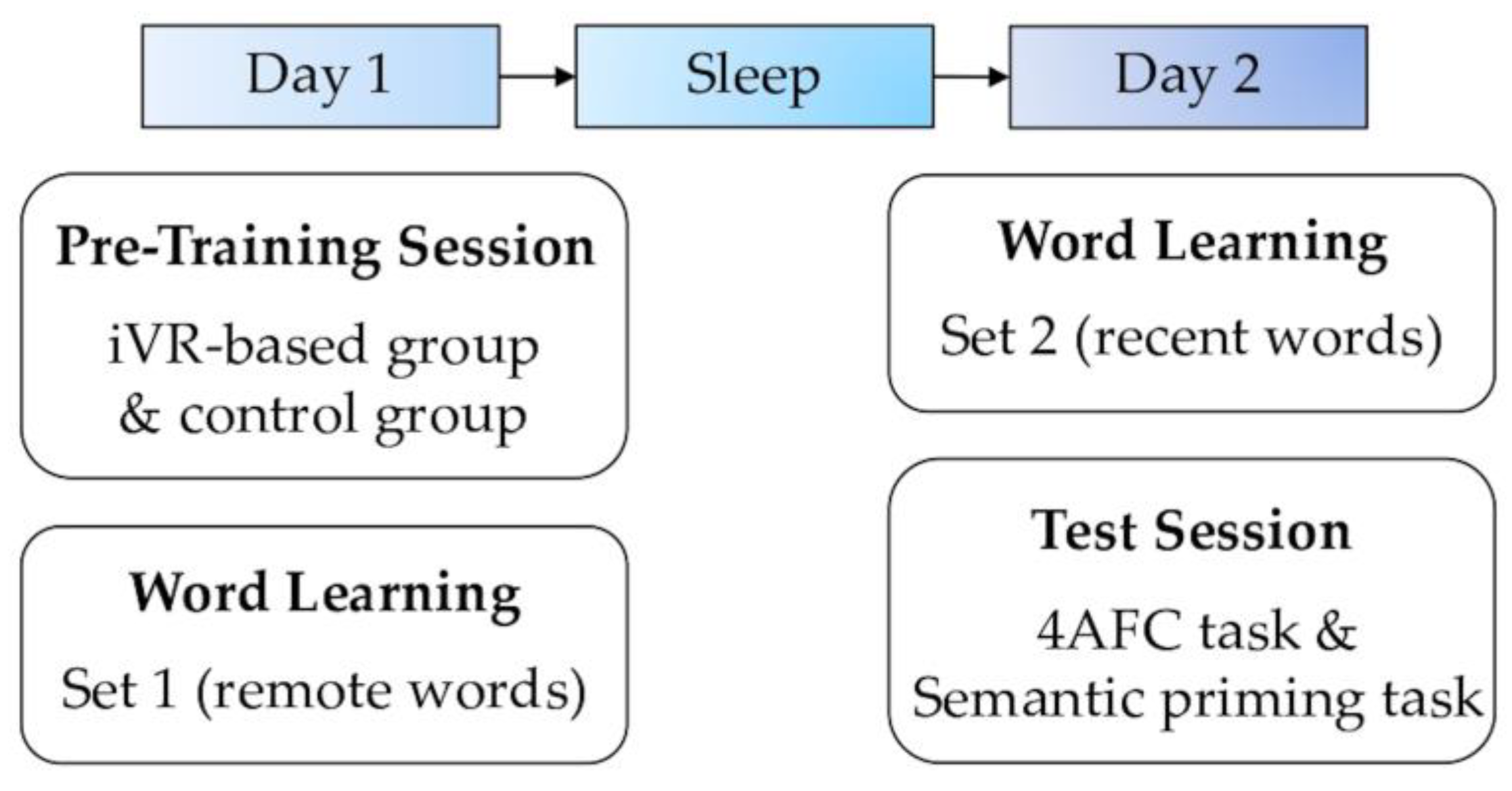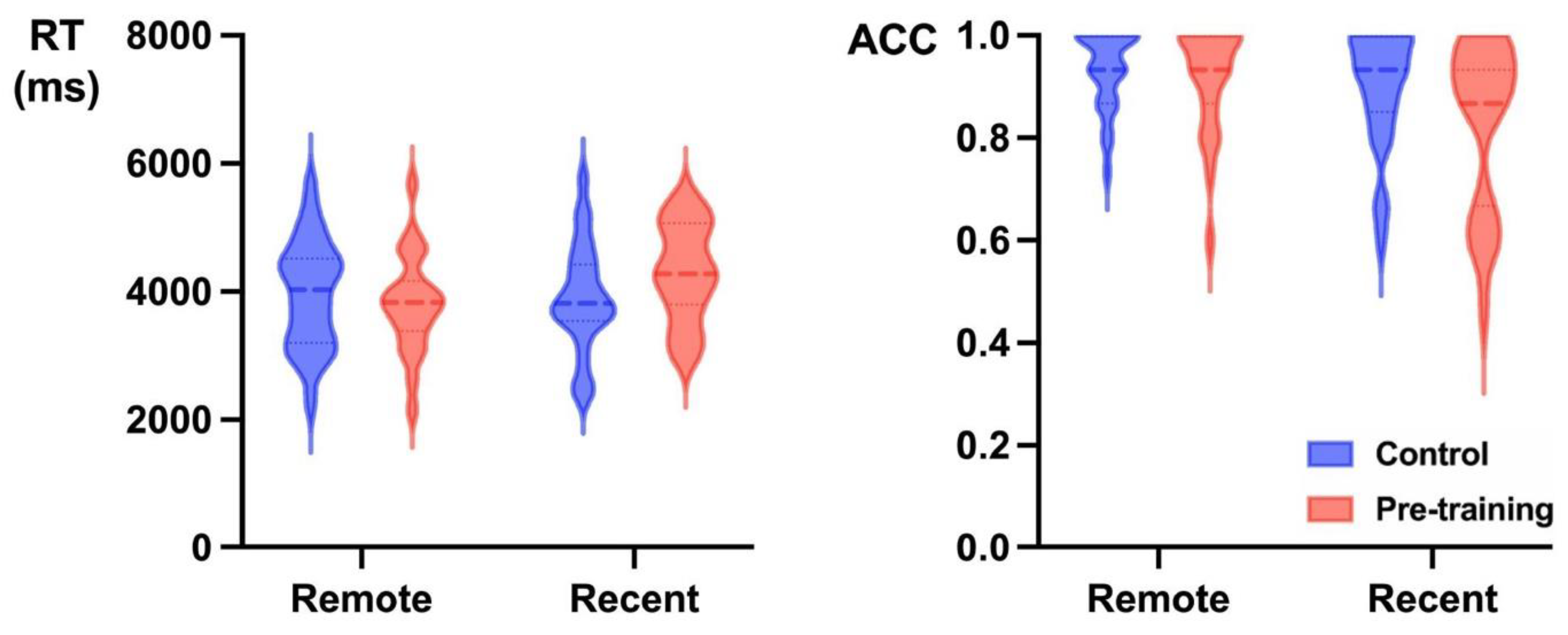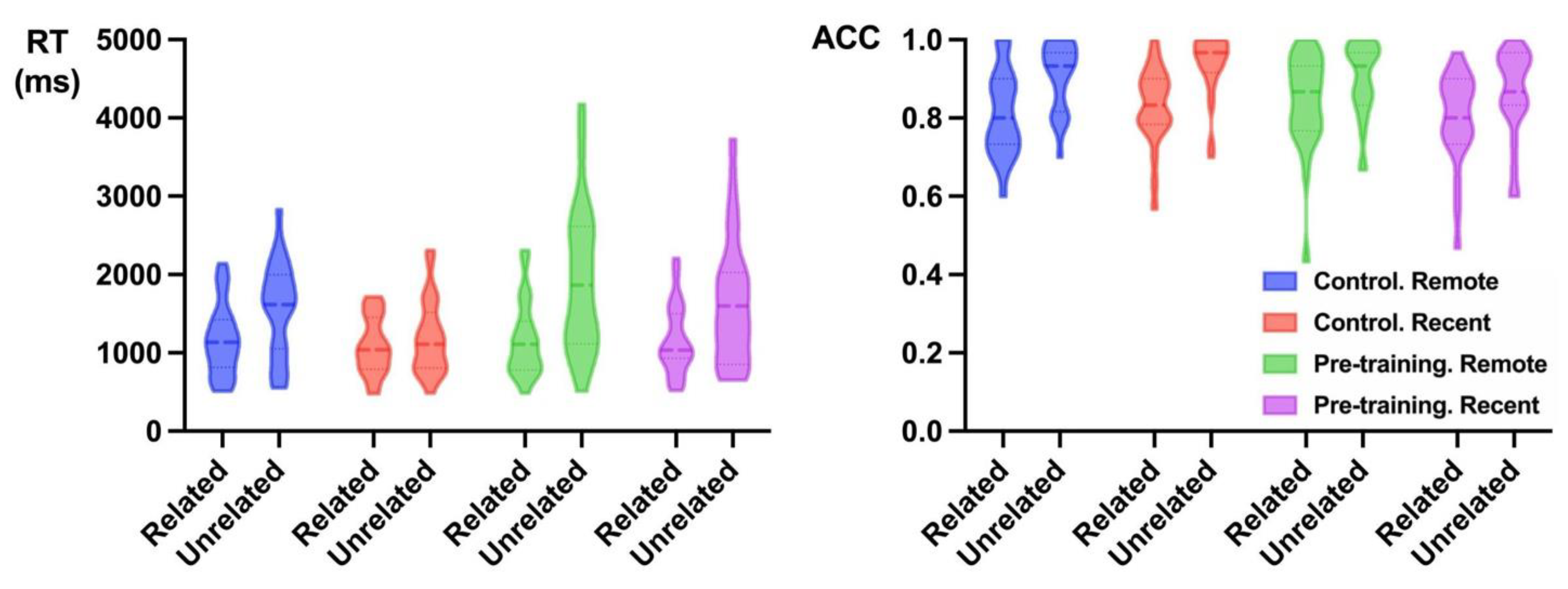Pre-Training Effects on Sleep-Dependent Consolidation of Novel Word Learning in Immersive Virtual Reality
Abstract
1. Introduction
1.1. Sleep-Dependent Consolidation Effects on Novel Word Learning
1.2. Pre-Training Principle in Multimedia Learning
1.3. The Present Study
2. Materials and Methods
2.1. Participant
2.2. Materials and Procedures
2.2.1. VR Pre-Training Session
2.2.2. VR Learning Session
2.2.3. Test Session
2.3. Data Analysis
3. Results
3.1. The 4AFC Task
3.2. The Semantic Priming Task
4. Discussion
4.1. Sleep-Dependent Consolidation in iVR Environment
4.2. The Role of Pre-Training
5. Conclusions
Author Contributions
Funding
Institutional Review Board Statement
Informed Consent Statement
Data Availability Statement
Conflicts of Interest
References
- Alfadil, Mohammed. 2020. Effectiveness of virtual reality game in foreign language vocabulary acquisition. Computers & Education 153: 103893. [Google Scholar] [CrossRef]
- Arztmann, Michaela, Jessica Lizeth Domínguez Alfaro, Lisette Hornstra, Jacqueline Wong, Johan Jeuring, and Liesbeth Kester. 2025. To move or not to move? The effect of active versus passive pre-training on cognitive load and in-game performance in an AR game. British Journal of Educational Technology 56: 2251–70. [Google Scholar] [CrossRef]
- Bakker, Iske, Atsuko Takashima, Janet G. van Hell, Gabriele Janzen, and James M. McQueen. 2014. Competition from unseen or unheard novel words: Lexical consolidation across modalities. Journal of Memory and Language 73: 116–30. [Google Scholar] [CrossRef]
- Barr, Dale J., Roger Levy, Christoph Scheepers, and Harry J. Tily. 2013. Random effects structure for confirmatory hypothesis testing: Keep it maximal. Journal of Memory and Language 68: 255–78. [Google Scholar] [CrossRef]
- Barsalou, Lawrence W. 2008. Grounded cognition. Annual Review of Psychology 59: 617–45. [Google Scholar] [CrossRef]
- Bates, Douglas, Martin Maechler, Ben Bolker, Steven Walker, Rune Bojesen Christensen, Henrik Singmann, Bin Dai, Fabian Scheipl, Gabor Grothendieck, and Peter Green. 2014. Lme4: Linear Mixed-Effects Models Using Eigen and S4, R Package Version 1.1-12. Available online: https://cran.r-project.org/web/packages/lme4/lme4.pdf (accessed on 26 October 2025).
- Clarke, Tracey, Paul Ayres, and John Sweller. 2005. The impact of sequencing and prior knowledge on learning mathematics through spreadsheet applications. Educational Technology Research and Development 53: 15–24. [Google Scholar] [CrossRef]
- Davis, Matthew H., and M. Gareth Gaskell. 2009. A complementary systems account of word learning: Neural and behavioural evidence. Philosophical Transactions of the Royal Society B: Biological Sciences 364: 3773–800. [Google Scholar] [CrossRef]
- Dumay, Nicolas, and M. Gareth Gaskell. 2007. Sleep-associated changes in the mental representation of spoken words. Psychological Science 18: 35–39. [Google Scholar] [CrossRef]
- Jiao, Lu, Mengrui Zhu, Zijie Xu, Guanzhu Zhou, John W. Schwieter, and Cong Liu. 2024. An ERP study on novel word learning in an immersive virtual reality context. Bilingualism: Language and Cognition 27: 128–36. [Google Scholar] [CrossRef]
- Jiao, Lu, Yue Lin, John W. Schwieter, and Cong Liu. 2025. Learning novel words in an immersive virtual-reality context: Tracking lexicalization through behavioral and event-related-potential measures. Language Learning. [Google Scholar] [CrossRef]
- Kester, Liesbeth, Paul A. Kirschner, and Jeroen J. van Merriënboer. 2004. Timing of information presentation in learning statistics. Instructional Science 32: 233–52. [Google Scholar] [CrossRef]
- Kumaran, Dharshan, Demis Hassabis, and James L. McClelland. 2016. What learning systems do intelligent agents need? Complementary learning systems theory updated. Trends in Cognitive Sciences 20: 512–34. [Google Scholar] [CrossRef] [PubMed]
- Lawson, Alyssa P., and Richard E. Mayer. 2025. Effect of pre-training and role of working memory characteristics in learning with immersive virtual reality. International Journal of Human–Computer Interaction 41: 2523–40. [Google Scholar] [CrossRef]
- Legault, Jennifer, Jiayan Zhao, Ying An Chi, Weitao Chen, Alexander Klippel, and Ping Li. 2019. Immersive virtual reality as an effective tool for second language vocabulary learning. Languages 4: 13. [Google Scholar] [CrossRef]
- Lei, Daisy, Yushuang Liu, and Janet G. van Hell. 2022. Novel word learning with verbal definitions and images: Tracking consolidation with behavioral and event-related potential measures. Language Learning 72: 941–79. [Google Scholar] [CrossRef]
- Li, Ping, and Hyeonjeong Jeong. 2020. The social brain of language: Grounding second language learning in social interaction. Npj Science of Learning 5: 8. [Google Scholar] [CrossRef]
- Liu, Cong, Yanna Mao, Xiaohan Wang, John W. Schwieter, and Lu Jiao. 2024. Sleep-dependent consolidation effects on foreign language word acquisition in a virtual reality environment. Memory & Cognition 52: 302–11. [Google Scholar]
- Liu, Yushuang, and Janet G. van Hell. 2020. Learning novel word meanings: An ERP study on lexical consolidation in monolingual, inexperienced foreign language learners. Language Learning 70: 45–74. [Google Scholar] [CrossRef]
- Makransky, Guido, and Gustav B. Petersen. 2021. The Cognitive Affective Model of Immersive Learning (CAMIL): A theoretical research-based model of learning in immersive virtual reality. Educational Psychology Review 33: 937–58. [Google Scholar] [CrossRef]
- Makransky, Guido, and Lau Lilleholt. 2018. A structural equation modeling investigation of the emotional value of immersive virtual reality in education. Educational Technology Research and Development 66: 1141–64. [Google Scholar] [CrossRef]
- Mayer, Richard E. 2021. Cognitive theory of multimedia learning. In The Cambridge Handbook of Multimedia Learning, 3rd ed. Edited by Richard E. Mayer and Logan Fiorella. Cambridge: Cambridge University Press, pp. 57–72. [Google Scholar]
- Mayer, Richard E., and Logan Fiorella. 2021. Principles for reducing extraneous processing in multimedia learning. In The Cambridge Handbook of Multimedia Learning, 3rd ed. Edited by Richard E. Mayer and Logan Fiorella. Cambridge: Cambridge University Press, pp. 185–98. [Google Scholar]
- Mayer, Richard E., Guido Makransky, and Jocelyn Parong. 2023. The promise and pitfalls of learning in immersive virtual reality. International Journal of Human–Computer Interaction 39: 2229–38. [Google Scholar] [CrossRef]
- Meyer, Oliver A., Magnus K. Omdahl, and Guido Makransky. 2019. Investigating the effect of pre-training when learning through immersive virtual reality and video: A media and methods experiment. Computers & Education 140: 103603. [Google Scholar] [CrossRef]
- Miguel-Alonso, Ines, David Checa, Henar Guillen-Sanz, and Andres Bustillo. 2024. Evaluation of the novelty effect in immersive virtual reality learning experiences. Virtual Reality 28: 27. [Google Scholar] [CrossRef]
- Palma, Pauline, and Debra Titone. 2021. Something old, something new: A review of the literature on sleep-related lexicalization of novel words in adults. Psychonomic Bulletin & Review 28: 96–121. [Google Scholar]
- Sweller, John. 2010. Element interactivity and intrinsic, extraneous and germane cognitive load. Educational Psychology Review 22: 123–38. [Google Scholar] [CrossRef]
- Sweller, John, Jeroen J. van Merriënboer, and Fred Paas. 2019. Cognitive architecture and instructional design: 20 years later. Educational Psychology Review 31: 261–92. [Google Scholar] [CrossRef]
- Tamminen, Jakke, and M. Gareth Gaskell. 2013. Novel word integration in the mental lexicon: Evidence from unmasked and masked semantic priming. Quarterly Journal of Experimental Psychology 66: 1001–25. [Google Scholar] [CrossRef] [PubMed]
- Wu, Bian, Xiaoxue Yu, and Xiaoqing Gu. 2020. Effectiveness of immersive virtual reality using head-mounted displays on learning performance: A meta-analysis. British Journal of Educational Technology 51: 1991–2005. [Google Scholar] [CrossRef]



Disclaimer/Publisher’s Note: The statements, opinions and data contained in all publications are solely those of the individual author(s) and contributor(s) and not of MDPI and/or the editor(s). MDPI and/or the editor(s) disclaim responsibility for any injury to people or property resulting from any ideas, methods, instructions or products referred to in the content. |
© 2025 by the authors. Licensee MDPI, Basel, Switzerland. This article is an open access article distributed under the terms and conditions of the Creative Commons Attribution (CC BY) license (https://creativecommons.org/licenses/by/4.0/).
Share and Cite
Liu, Z.; Jiao, L. Pre-Training Effects on Sleep-Dependent Consolidation of Novel Word Learning in Immersive Virtual Reality. J. Intell. 2025, 13, 137. https://doi.org/10.3390/jintelligence13110137
Liu Z, Jiao L. Pre-Training Effects on Sleep-Dependent Consolidation of Novel Word Learning in Immersive Virtual Reality. Journal of Intelligence. 2025; 13(11):137. https://doi.org/10.3390/jintelligence13110137
Chicago/Turabian StyleLiu, Zhengyu, and Lu Jiao. 2025. "Pre-Training Effects on Sleep-Dependent Consolidation of Novel Word Learning in Immersive Virtual Reality" Journal of Intelligence 13, no. 11: 137. https://doi.org/10.3390/jintelligence13110137
APA StyleLiu, Z., & Jiao, L. (2025). Pre-Training Effects on Sleep-Dependent Consolidation of Novel Word Learning in Immersive Virtual Reality. Journal of Intelligence, 13(11), 137. https://doi.org/10.3390/jintelligence13110137



